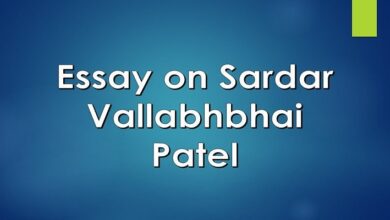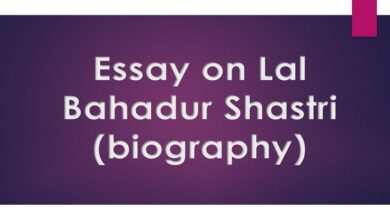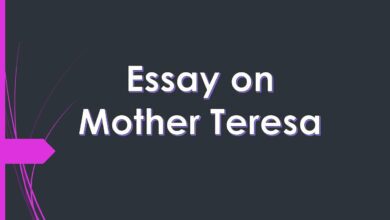Essay on Swami Dayanand Saraswati 1000 Words in English | PDF
Essay on Swami Dayanand Saraswati
Essay on Swami Dayanand Saraswati in English (Download PDF) – we will throw light on the life of Swami Dayanand Saraswati. How did he work for the betterment of society and religion? Why did he die and what did he do for society? So let’s start.
Role
India is a religious country. The people here are directly and indirectly related to religion. When the true nature of religion was disappearing. Then there was also going to be a social decline of the human here. When hypocrites were dominated in the name of religion.
Superstition was spreading in the hearts of the people. On the one hand, Indian society was suffering from many evils and corrupted traditions in the name of religion, on the other hand, the exploitation of the society by foreign rulers was also in full swing. In such odd and dire circumstances, the reformist religious leader Rishi Dayanand was born on this land of India.
Birth and Education
Maharishi Dayanand Saraswati was born in the year 1824 in a village called Tankara in Gujarat province. His father’s name was Shri Amba Shankar who was an exclusive worshiper of Shiva.
The original name of the Maharishi was Mool Shankar. In his childhood, his father sent him to Sanskrit school. Due to his sharp intellect, he got complete knowledge of Sanskrit only at the young age of twelve years. He had an interest in the exploration of truth since childhood.
Common Events and Changes of Mind
Once on the day of Shivratri, along with all the family members, the child Mool Shankar also kept a fast. In the evening all the devotees went to the Shiva temple for visit. He saw a mouse eating the ‘prasad’ offered to Shiva and also walking on top of the idol.
This scene caused a radical change in the mind of the child. He wondered what the Lord would protect others who could not protect the offerings offered to him. What is the truth in their heart since then? The desire to know this increased.
Read also – Essay on Sardar Vallabh Bhai Patel
Home Renunciation and Search for Knowledge
The incident of Shivratri had sown the seeds of curiosity and detachment in him. The death of his uncle and sister shook his heart and mind. He began to think of the world as momentary and mortal. Seeing his disinterest, his father decided to marry him.
But this was not acceptable to the original Shankara. At the age of 21, he left home and set out in search of true knowledge. He visited many pilgrimages, monasteries, ashrams, religious places but his thirst for knowledge was not quenched.
Recognition and Naming of Guru
Finally, he reached Swami Brij Anand Ji’s ashram in Mathura while visiting various shrines. He has been greatly influenced by his satsangs and discourses. By taking initiation from him, his thirst for knowledge was pacified and all the entangled knots of the heart were resolved.
According to Indian tradition, a disciple who retires after receiving initiation is given a new name. That is why the original Shankar, who had compassion for living beings, was named Dayanand. The Guru said, Dayanand, look at the condition of the world. He is reaching the abyss. Let this Veda sound resonate in the whole world. This is my ‘Guru Dakshina’.
Propagation of Religion and Establishment of Arya Samaj
After getting the permission of the Guru, he set out for the propagation of religion. First reached Haridwar Kumbh Mela. He hoisted the flag of hypocrisy. He started preaching the Vedas from one city to another. Argued from place to place. He founded Arya Samaj in Mumbai for his organized propaganda.
Visited all the big cities. He met many kings and maharajas in his country. He also met the then Viceroy. Many kings and maharajas respected him. Opposing idol worship, refutation of hypocrisy, opposition to untouchable discrimination, opposition to child marriage and mismatch marriage, destruction of evils, propagation of Vedas are the basic principles of Arya Samaj established by him. He composed the book ‘Satyarth Prakash’ which is the honorable religious text of Arya Samaj.
Read also – Essay on Lala Bahadur Shastri
Swamiji’s Death
His death also happened as a result of his resistance to the evils. Once Jaswant Singh, the king of Jodhpur, was shouldering the palanquin of a prostitute. Sage Dayanand explained to him that as a king, he should not do such an inferior thing. On this, the prostitute has tried to avenge her insult. He made his cook Jagannath ready for this. The cook grinded the glass in milk and gave it to Swamiji, after drinking which his life was blown away.
Epilogue
Heartfelt gratitude to all the enlightened people on the death of Swamiji. But even though he is not among us, he is giving his message till the ages. His messages are taking us towards the right path even today.
The principles which were of Rishi Dayanand, have been implemented in society by the Government of India today. That’s why his immortal message will keep us overcome with superstition from time to time. The Indian society will always remember Rishi Dayanand and get inspiration through his invaluable teachings.
Download PDF – Click Here
FAQs. on Swami Dayanand Saraswati
Why is Dayanand Saraswati famous?
Ans – Dayanand Saraswati was the first Indian to voice his right for India’s independence from British rule in 1876. In addition, he was a prominent Hindu religious leader and a Vedic scholar. He was completely devoted to God and he translated the Vedas from Vedic Sanskrit into Sanskrit and Hindi so that the common man could gain its knowledge.
Who killed Dayanand Saraswati?
Ans – The founder of Arya Samaj Swami Dayanand Saraswati was assassinated by a person named Jagannath on 23 December 1926.
What did Dayanand Saraswati do?
Ans – He was a social leader, Indian philosopher, and founder of Arya Samaj, the reform movement of Vedic religion. He believed in the knowledge of the Vedas. He advocated the doctrine of karma and reincarnation.
What are the achievements of Dayanand Saraswati?
Ans – He founded gurukuls and societies to impart Vedic education and was one of the most radical socio-religious reformers in the history of India.




